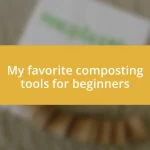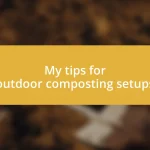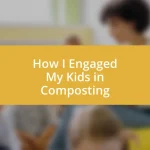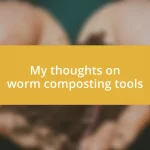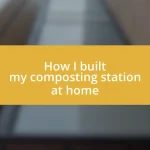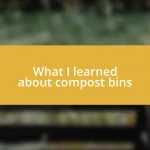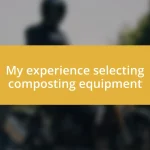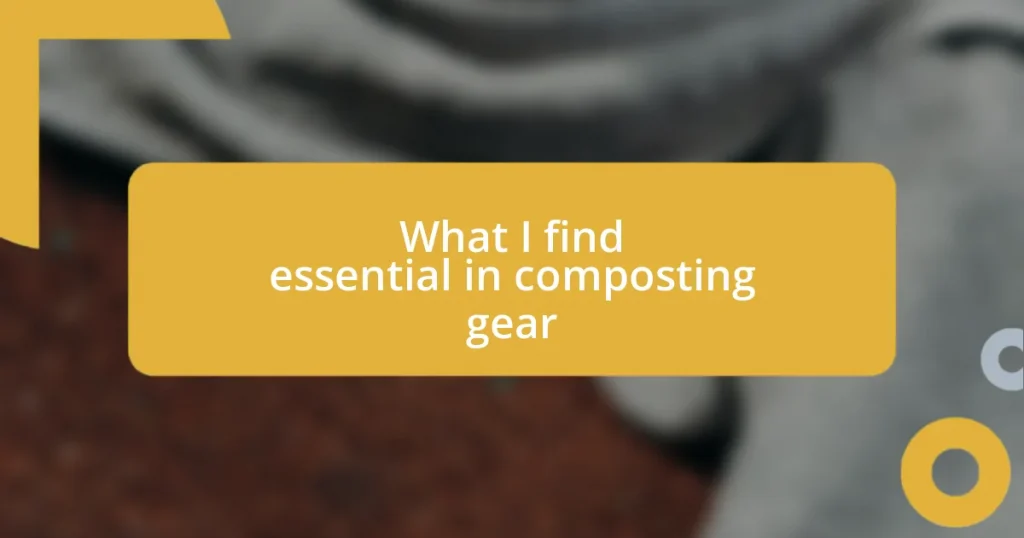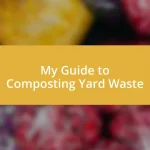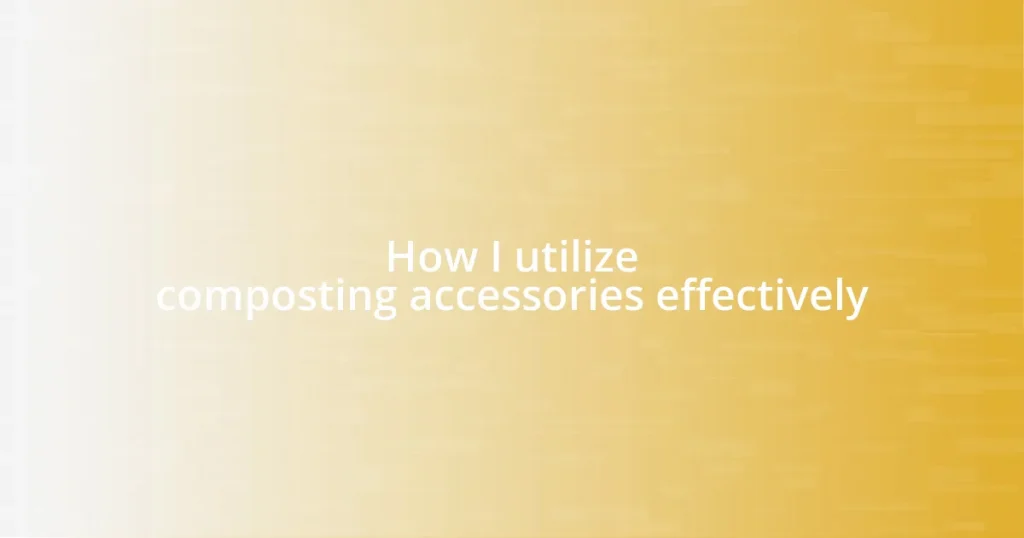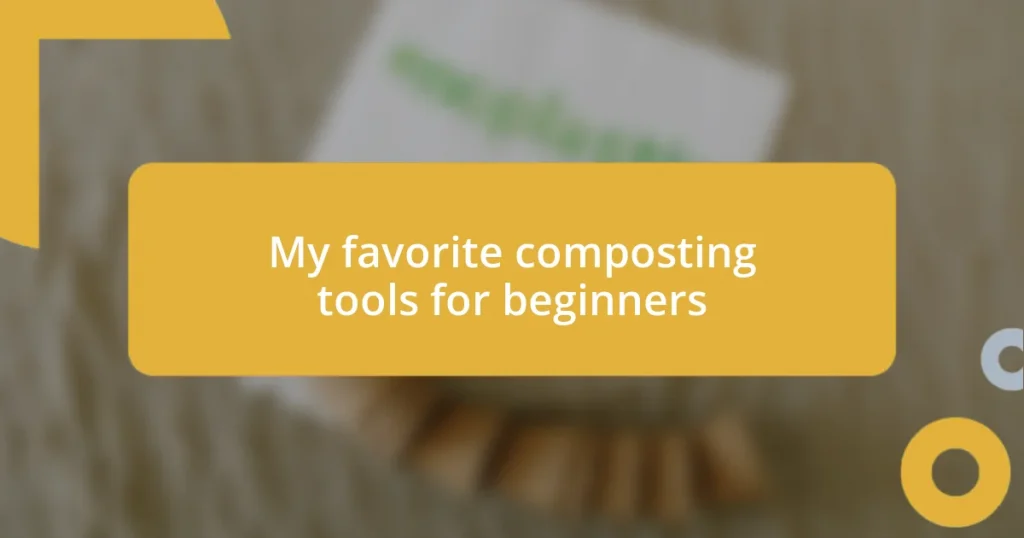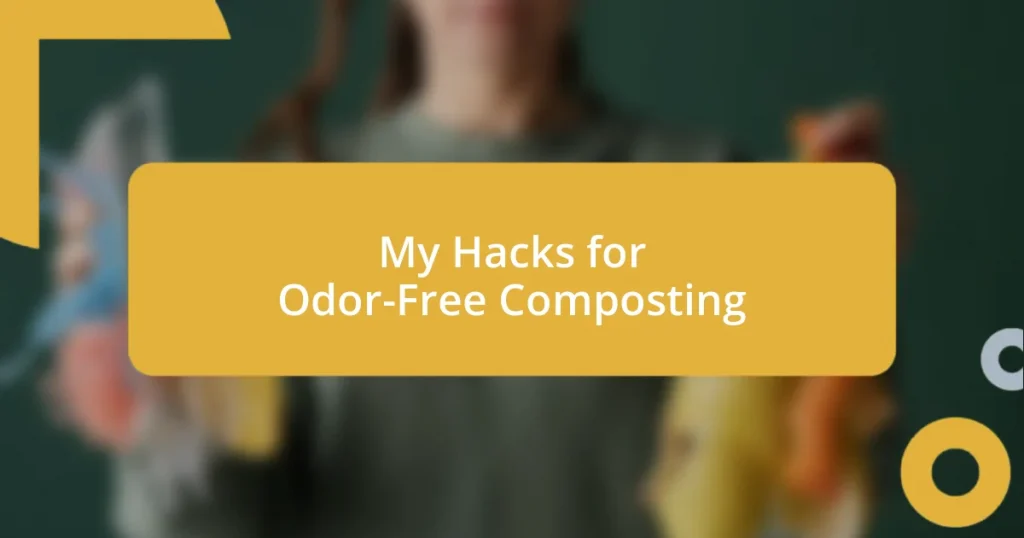Key takeaways:
- Choosing the right compost bin is crucial; look for durability, ventilation, and size to match your composting needs.
- Essential composting tools such as a thermometer, aerator, and gloves can greatly enhance the composting process and experience.
- Maintaining compost quality involves regular aeration, monitoring moisture levels, and ensuring a proper balance of greens and browns to avoid odors and pests.

Essential composting gear overview
When I think about composting gear, the first thing that comes to mind is a sturdy compost bin. Having tried out various models, I can’t stress enough how crucial it is to find one that suits your space and lifestyle. I remember my first bin—it was a flimsy model that barely held up, bringing more frustration than joy to my composting experience. Isn’t it interesting how the right tools can make all the difference?
Another essential item is a good compost aerator. This tool not only speeds up the decomposition process but also saves you from the back-breaking work of turning your compost pile manually. I once used a pitchfork for this, and while it worked, the aerator has honestly changed the game for me. Have you ever felt how light and airy a well-aerated pile feels? It’s surprisingly satisfying!
Finally, don’t overlook the importance of a kitchen scraps container. I’ve found that using one encourages me to compost more effectively. It’s like having a little reminder in your kitchen to make more sustainable choices. Every time I empty that container into my outdoor bin, it feels like I’m giving back to the earth in a small but meaningful way. What’s in your kitchen that you could compost today?

Key features of compost bins
When it comes to compost bins, one key feature I look for is durability. A compost bin needs to be able to withstand various weather conditions. I recall one winter when my plastic bin cracked during a cold snap, leaving me to fend off a mess. Now, I always opt for a robust material that promises longevity.
Another essential aspect is ventilation. Good airflow is vital for decomposition, and bins designed with vents help achieve this. I vividly remember the musty smell of my unventilated compost heap, which served as a reminder that proper air circulation can significantly improve my results. Have you ever noticed how a well-aerated compost pile smells fresh rather than overpowering?
Size is equally important. Depending on your needs, a larger bin might be necessary for handling bigger volumes of kitchen scraps and yard waste. I’ve found that having one that accommodates my family’s composting habits without overflowing helps keep me organized and motivated. It’s about finding the right fit for your lifestyle and space, ensuring composting is an enjoyable process.
| Feature | Description |
|---|---|
| Durability | Sturdy materials that withstand weather conditions. |
| Ventilation | Allows for airflow, essential for effective decomposition. |
| Size | Makes managing compost easier by fitting specific needs. |

Best tools for composting
When it comes to the best tools for composting, I can’t help but rave about a reliable compost thermometer. It was a game-changer for me. The first time I checked the temperature of my compost pile, I was surprised to see it reaching over 150°F! This not only indicated that the decomposition process was thriving, but it also reassured me that I was on the right track. Trust me, monitoring your compost’s heat can transform a hit-or-miss experience into a successful, proactive one.
Another must-have is a good set of composting gloves. I learned this the hard way. The first time I dove into my compost bin without gloves, the smell and texture overwhelmed me. Now, I choose gloves that are both sturdy and comfortable, letting me dig in without hesitation. It feels empowering to mix my compost freely, knowing my hands are protected.
Here are some additional tools that served me well:
- Compost Sifter: Helps separate finished compost from larger materials, ensuring a fine mix.
- Handheld Trowel: Perfect for reaching deep into bins or topping off garden beds with compost.
- Mulching Mower: Allows me to finely chop yard waste before it hits the compost, helping speed along decomposition.
- Bamboo Stakes: These are great for keeping my piles organized and marking layers, guiding me as I layer greens and browns effectively.
I often remind myself that these tools can significantly enhance my composting journey. Investing in the right gear not only saves time but turns a mundane chore into a rewarding experience. What tools have you found indispensable?

Types of composting systems
There are several types of composting systems available, and each comes with its unique advantages. For instance, I’ve had great success with traditional compost bins. These static systems are straightforward. You simply add materials over time, allowing them to decompose at their own pace. I once started with a basic wooden bin, and while it required regular turning for aeration, the satisfaction of producing rich, dark compost was worth the effort.
Turning now to a more active system, I really enjoy using a compost tumbler. They make it easy to mix materials without the heavy lifting that can come with traditional bins. I remember my first tumbler; it was like a child discovering a new toy. The ease of spinning it to aerate the pile and speeding up decomposition was exhilarating. Have you tried one? You might find it transforms the task into a more engaging experience.
Then there’s vermicomposting, which utilizes worms to break down organic material. This system really ups the ante with composting, and I can’t recommend it highly enough for small spaces. When I first introduced worms into my composting routine, it felt oddly satisfying to witness them work their magic. Watching them flourish while transforming kitchen scraps into nutrient-rich castings is a joy. It’s composting at its finest, showcasing nature’s incredible efficiency.

Choosing biodegradable materials
Choosing biodegradable materials is essential for any composting enthusiast, and I’ve learned a few key points from my own experience. Initially, I only thought of food scraps, but I found out that things like cardboard and paper can also be composted, as long as they’re not glossy or heavily inked. Imagine my surprise when I tossed in the remnants of my kids’ art projects and saw them break down into nutrient-rich compost over time!
While it’s easy to throw in just any organic material, I quickly realized that balance is crucial. During my first composting attempt, I overloaded my pile with kitchen scraps. The result? A soggy mess that didn’t decompose properly. It taught me to pair greens, like fruit scraps, with browns, like dried leaves, to create a healthy mix. Have you encountered a similar hiccup? Learning from those early mistakes made me appreciate the importance of proper ratios in my composting journey.
What really excites me is knowing that choosing the right biodegradable materials can significantly impact the quality of my compost. I remember the first time I mixed in coffee grounds and eggshells; the richness of the end product amazed me. Each component plays a role, and understanding this truly enhances the composting process. So, if you’re venturing into composting, consider not just what you put in, but how the combination can create a vibrant ecosystem that nourishes your garden!

Maintaining compost quality
Maintaining compost quality goes beyond simply throwing organic waste into a bin. I’ve found that consistent aeration is key; without it, the materials can turn anaerobic and begin to smell. I remember neglecting this part once and was greeted by a pungent odor that made me rethink my approach altogether. Since then, I’ve adopted a regular turning schedule, and it has made all the difference, transforming my compost into a sweet-smelling, thriving ecosystem.
Moisture levels also play a crucial role in maintaining compost quality. I learned the hard way that a dry pile doesn’t break down effectively. After a few weeks of frustration, I started monitoring moisture levels more closely, ensuring it was damp but not soggy—like a wrung-out sponge. It’s amazing how a little bit of water can revive a struggling pile. Have you felt that sense of accomplishment when your compost starts to heat up again?
Finally, I can’t stress enough the importance of monitoring temperatures. When I first dove into composting, I was unprepared for how hot things could get in there! Keeping track of the internal temperature can help you understand if your compost is breaking down efficiently. A thermocouple—sounds fancy, right?—has become my little secret weapon, guiding my efforts. I still get excited when I see that thermometer rise, knowing I’m on the right track to producing high-quality compost. It’s like being part of a science experiment where the rewards are tangible and so satisfying!

Troubleshooting common composting issues
I’ve encountered my fair share of composting challenges, but one common issue that often pops up is attracting unwelcome pests. I remember my first compost pile developed a whole squad of fruit flies due to overly ripe banana peels just tossed in without thought. What a nuisance! I quickly learned that burying food scraps beneath a layer of browns not only minimizes odors but also helps keep those pesky flies at bay. Have you experienced a similar invasion? It’s amazing how a small adjustment can drastically improve the composting experience.
Another frequent hurdle involves a compost pile that seems to be taking forever to break down. I faced this dilemma, feeling frustrated as I stirred my pile, still seeing recognizable bits of vegetable scraps. After some digging into composting resources, I realized that particle size matters; smaller pieces decompose faster. I started chopping up my kitchen waste—what a game changer! I felt a wave of satisfaction when I saw my compost start to take shape faster, almost like watching a magic trick unfold right in my backyard.
Lastly, a key issue many face is the smell. I once had a situation where my compost emitted a sour odor that wafted through the yard. Pretty embarrassing! This was a wake-up call for me to check my ratios of greens to browns. Too many nitrogen-rich materials were the culprits, so I added dry leaves and cardboard to restore balance. That delightful earthy smell we all strive for returned, and trust me, there’s nothing like the aromatic satisfaction of a well-maintained compost pile. Have you found a smell that made you cringe? It’s all part of the journey—and indeed, a lesson learned for future composting efforts!

